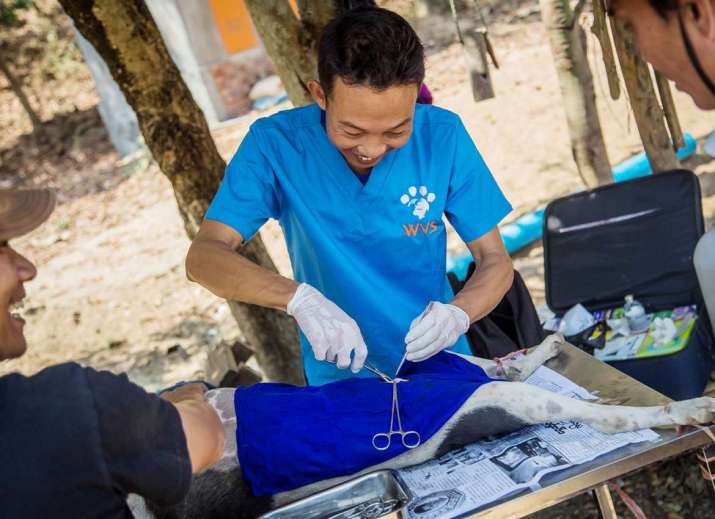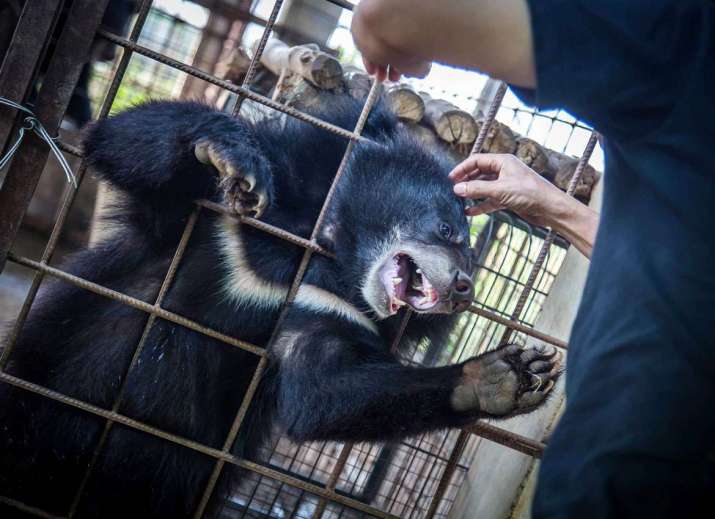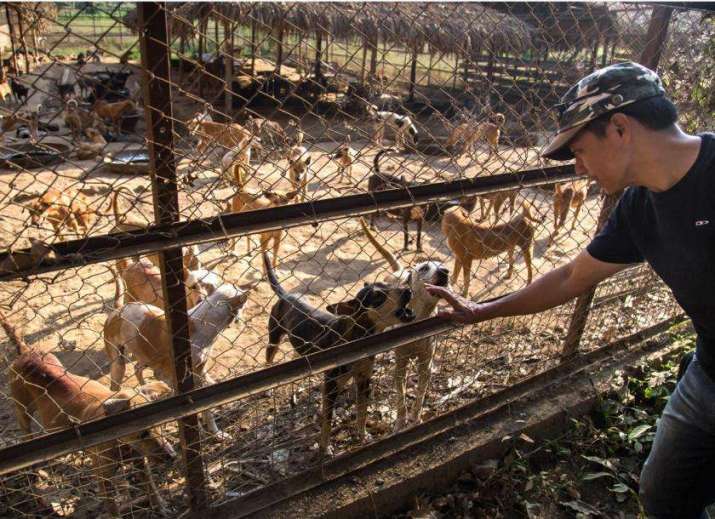NEWS
Myanmar Animal Shelter Uses Buddhist Chants to Soothe Stray Dogs
 A puppy looks on eagerly as a pot of rice is prepared for the animals’ meals. Photo by Aung Myin Ye Zaw. From mmtimes.com
A puppy looks on eagerly as a pot of rice is prepared for the animals’ meals. Photo by Aung Myin Ye Zaw. From mmtimes.comAn animal shelter in Myanmar has taken a novel approach to mongrel management by turning to the Dharma in a bid to engender a more harmonious living environment for the homeless hounds who find refuge there. According to recent media reports, Thabarwa Animal Shelter has found that piping in Buddhist chants has a calming effect on its population of once-peripatetic pooches.
Not only does playing prerecorded Buddhist chants twice each day make the resident canines “less aggressive,” according to the animal shelter’s manager, U Maung Maung Oo, the chants also help contain the center’s population of dogs, most of whom have not been neutered. “We find that the dogs don’t mate . . . when we play Dharma preaching,” he explained. (Mizzima)
Thabarwa Animal Shelter, part of the life’s work of Buddhist monk Sayadaw U Ottamasara, was established within a 52.5-hectare site on the edge of the Bago Yoma mountain range, some 45 kilometers northeast of the former Myanmar capital Yangon, in 2016 to provide a safe refuge for homeless animals without any limit on the numbers or health condition of the animals for which it provides shelter.
The center is aimed at providing a safe home where rescued animals can live without fear, and where they can be fed and receive any necessary medical attention. According to the Thabarwa website:
As there is no limit of number we get more animals than donations but we will keep on accepted them [however] long it is. The final plan is to build a nature reserve where animals are protecting from any harm and predator. We are developing right now the road to make the center more accessible for the doctor and are finishing to build the cow and buffalo shelters, their water ponds and many others facilities. (ThaBarWa Centre)
 Veterinarian Dr. Zaw Ye Naing operates on a dog at the shelter. Photo by Aung Myin Ye Zaw. From mmtimes.com
Veterinarian Dr. Zaw Ye Naing operates on a dog at the shelter. Photo by Aung Myin Ye Zaw. From mmtimes.comThe shelter’s founder, Sayadaw U Ottamasara, also established Thabarwa Taya Home in the port city of Thanlyin as a non-profit humanitarian organization that takes care of the poor, needy, and aged. He set up the center in 2008 to teach meditation, but quickly realized that there was a need to provide permanent homes for some elderly yogis who had been abandoned by their families. As more and more people came, he decided to develop Thabarwa into a home for the needy. After acquiring more land with the help of donors, Sayadaw Ottamasara expanded his services to include two new centers in Myanmar’s Ayeyarwady Region, and nearly a dozen meditation centers around the country. Another 73-hectare Saytanar Village for 500 families has also been set up in near the animal sanctuary.*
Today, Thabarwa Animal Shelter is now home to approximately 2,000 stray dogs, as well as 200 cows, 80 buffaloes, 70 cats, 50 goats, 30 chickens, 17 pigs, three black bears, and two foxes.**
“We try to feed [our animals] on fruit and fish that they can hunt in the forest but we still can’t create a place which closely resembles their natural habitat and we can’t feed them all the nutrients they need. We still have many weaknesses,” said Maung Maung Oo. (Myanmar Times)
In recent weeks, the number of dogs living at the shelter has jumped from 900 in 2018 to 2,000 as the authorities in Yangon authorities have sought to control the city’s burgeoning population of strays. Now anywhere from 10–80 dogs arrive at the shelter each day, overwhelming Maung Maung Oo and his 40-strong team.
 Manager Maung Maung Oo plays with one of the Thabarwa Animal Shelter’s resident black bears. Photo by Aung Myin Ye Zaw. From mmtimes.com
Manager Maung Maung Oo plays with one of the Thabarwa Animal Shelter’s resident black bears. Photo by Aung Myin Ye Zaw. From mmtimes.comMedia reports indicate that a sterilization program initiated in 2016 has so far failed to have a long-term impact, and the growing canine population in Yangon—estimated to stand at around 200,000—presents a growing public risk in a country where rabies has yet to be eradicated. Roughly 1,000 people are believed to die from rabies each year in Myanmar, one of the highest rates in the world and one that some experts say is overly conservative.
Even leaving the threat of rabies aside, packs of often aggressive dogs on the streets of the country’s towns and cities also leave residents frustrated and afraid of being attacked. But while the authorities may be willing to take action, limited resources mean that the means are not always available, making any initiatives heavily reliant on corporate and individual donors.
The World Health Organisation (WHO) cautions that neither culling stray animal populations, nor capturing and rehousing are effective for eradicating the scourge of rabies, instead urging for the expensive and labor-intensive measure of mass vaccinations.
According to Dr. Marina Ivanova of Four Paws, a Vienna-headquartered NGO that reported vaccinating 58,386 animals against rabies in Myanmar in 2018 and aims to vaccinate one million dogs over the next three years, vaccinated dogs act “like a firewall. Once the animals are vaccinated in one territory, they will not get rabies and they will not spread the virus of rabies to the human population.” (Channel NewsAsia)
 Maung Maung Oo greets some of the growing number of dogs under his care. Photo by Aung Myin Ye Zaw. From mmtimes.com
Maung Maung Oo greets some of the growing number of dogs under his care. Photo by Aung Myin Ye Zaw. From mmtimes.comMyanmar is a predominantly Theravada Buddhist country, with 88 per cent of the population of 51.5 million people identifying as Buddhists, according to census data for 2014. Christians, folk religions, and Muslims make up the bulk of the remainder. Buddhist monks, venerated throughout Burmese society, are estimated to number around 500,000, with some 75,000 nuns in the Southeast Asian country.
* Thabarwa Centre — A Refuge for the Homeless in Myanmar (Buddhistdoor Global)
** Excluding dogs, animal population figures as of June 2018.
See more
Thabarwa Centre
Animal Shelter (ThaBarWa Centre)
TC " For You" Thabarwa Animal Shelter သင့္အတြက္ သဘာဝ တိရစာၦန္ေဘးမဲ့ေတာ (Facebook)
Buddhist chants calm stray Myanmar dogs (Mizzima)
Dharma Dogs: Buddhist chants calm stray Myanmar mutts (Channel NewsAsia)
A sanctuary in the mountains (Myanmar Times)
OVER 50,000 DOGS AND CATS VACCINATED IN MYANMAR (Four Paws International)
Related news from Buddhistdoor Global
UNESCO Declares Myanmar’s Ancient Buddhist Temple City Bagan a World Heritage Site
Interfaith Activists in Myanmar Defy Anti-Muslim Nationalists with #WhiteRose4Peace Campaign
Buddhist Pagoda in Myanmar Offers Refuge to Snakes
Growing Demand for Elephant Skin Drives Alarming Surge in Poaching in Myanmar
Myanmar Buddhist Recognizes the Right of All Children to Receive an Education
Related features from Buddhistdoor Global
Blind but not Lost
Twilight Villa – The Last Hope for Myanmar’s Sick and Abandoned Elderly
myMe: Hope on Wheels for Myanmar’s “Lost” Generation














